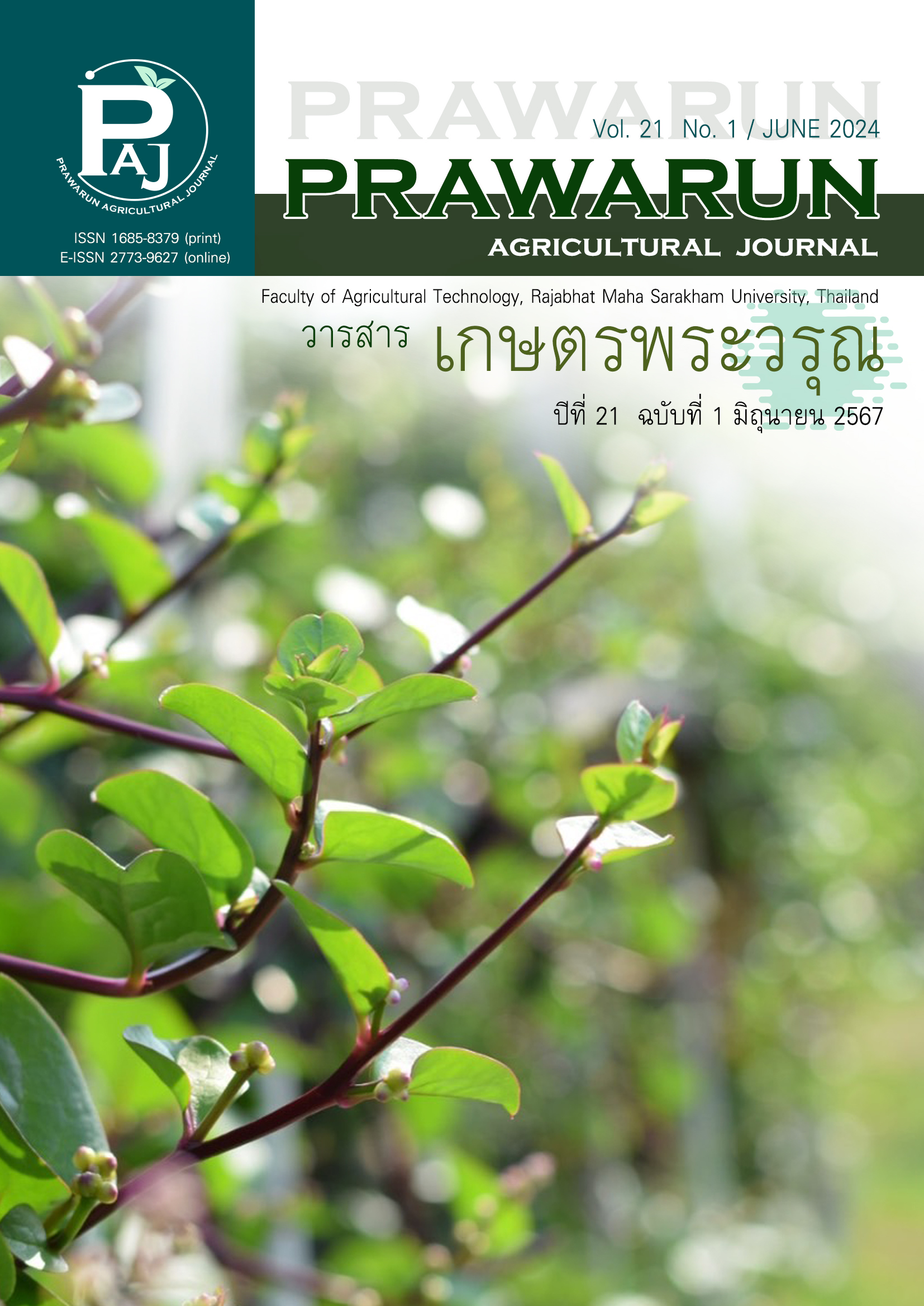ผลของสารให้ความหวานต่างชนิดต่อคุณภาพของเครื่องดื่มจากปลีกล้วย
Main Article Content
บทคัดย่อ
งานวิจัยนี้มีวัตถุประสงค์เพื่อศึกษาผลของสารให้ความหวานต่างชนิดต่อคุณภาพของเครื่องดื่มจากปลีกล้วย ผลิตน้ำปลีกล้วยด้วยการสกัดด้วยน้ำจากการต้มและปั่นละเอียด ปรับปรุงรสชาติหวานโดยผันแปรสารให้ความหวานจากธรรมชาติ จำนวน 5 สิ่งทดลอง คือ สูตรไม่ใส่สารให้ความหวาน (สูตรควบคุม) สูตรผสมน้ำตาลทรายแดงร้อยละ 5 สูตรผสมน้ำอินทผลัมร้อยละ 12 สูตรผสมน้ำตาลหล่อฮังก๊วยร้อยละ 4 และสูตรผสมน้ำเชื่อมหญ้าหวานร้อยละ 2 (w/w) ผลการศึกษา พบว่าสูตรผสมสารให้ความหวานมีของแข็งทั้งหมดที่ละลายได้และปริมาณของแข็งทั้งหมดสูงกว่าสูตรควบคุม ทุกสูตรของเครื่องดื่มมีความเป็นกรด มีค่าความเป็นกรด-ด่าง (pH) และปริมาณกรดทั้งหมด (กรดซิตริก) อยู่ระหว่าง 4.55 – 4.78 และร้อยละ 0.20 – 0.24 ตามลำดับ โดยสูตรผสมสารให้ความหวานมีค่า pH ต่ำกว่าสูตรควบคุม และทุกสูตรของเครื่องดื่มมีสีแดงอ่อน คล้ำเล็กน้อย มีค่าความสว่าง (L*) ค่าความเป็นสีแดง (a*) และค่าความเป็นสีเหลือง (b*) อยู่ระหว่าง 38.99 – 44.60, 10.22 – 14.49 และ 15.47 – 16.66 ตามลำดับ โดยสูตรผสมน้ำอินทผลัมมีค่าความสว่างต่ำกว่าสูตรอื่น ๆ ขณะที่ปริมาณสารประกอบฟีนอลิกทั้งหมด ร้อยละการยับยั้งอนุมูลอิสระ DPPH และฤทธิ์ต้านอนุมูลอิสระของสูตรผสมสารให้ความหวานไม่แตกต่างทางสถิติกับสูตรควบคุม (p>0.05) โดยมีค่าอยู่ระหว่าง 1,260.71 – 1,385.71 mg GAE/L 20.11 – 22.30 และ 1,981.54 – 2,197 mg TEAC/L ตามลำดับ ปริมาณสารแทนนินของทุกสูตรอยู่ระหว่าง 608.84 – 1,221.99 g/L สูตรผสมน้ำเชื่อมหญ้าหวานมีปริมาณแทนนินสูงกว่าสูตรอื่น ๆ (p≤0.05) ผลการประเมินทางประสาทสัมผัส พบว่า สูตรผสมน้ำเชื่อมหญ้าหวาน และสูตรผสมน้ำตาลหล่อฮังก๊วย ได้รับการยอมรับจากผู้บริโภคอยู่ในระดับชอบเล็กน้อย ซึ่งทั้ง 2 สูตรเป็นสูตรที่ให้พลังงานต่ำเหมาะกับคนที่ห่วงใยในสุขภาพและเหมาะสมในการพัฒนาเป็นผลิตภัณฑ์ทางการค้าต่อไป
Article Details
เอกสารอ้างอิง
Al-Harrasi, A., Rehman, N. U., Hussain, J., Khan, A. L., Al-Rawahi, A., Gilani, S. A., Al-Broumi, M., & Ali, L. (2014). Nutritional assessment and antioxidant analysis of 22 date palm (Phoenix dactylifera) varieties growing in Sultanate of Oman. Asian Pacific Journal of Tropical Medicine, 7(1), S591-S598. doi: 10.1016/S1995-7645(14)60294-7
Al-Shwyeh, H. A. (2019). Date palm (Phoenix dactylifera L.) fruit as potential antioxidant and antimicrobial agents. Journal of Pharmacy and Bioallied Sciences, 11(1), 1-11. doi: 10.4103/jpbs.JPBS_168_18
Amornlerdpison, D., Choommongkol, V., Narkprasom, K., & Yimyam, S. (2020). Bioactive compounds and antioxidant properties of banana inflorescence in a beverage for maternal breastfeeding. Applied Sciences, 11(1), 343. doi: 10.3390/app11010343
Association of Official Analytical Chemists (AOAC). (2000). Official methods of analysis (17thed.). Arlington, Virginia, United States: Association of Official Analytical Chemists.
Baotang, Z. (2018). Monk fruit extract: a new sweetener. Nutraceuticals Now, Spring 201, 70-71.
Chantaratheptimakul, S., & Santakul, A. (2022). Development of concentrates banana blossom ready to drink. Bangkok, Thailand: Rajamangala University of Technology Krungthep. (in Thai)
Fadel, H. H. M., Lotfy, S. N., Asker, M. M. S., Mahmoud, M. G., Abd El-Aleem, F. S., Ahmed, M. Y. S., & Saad, R. (2023). Effect of amino compounds on the volatile compounds and antioxidant activity of maillard reaction products of enzymatic hydrolyzed cabbage leaves. Applied Food Research, 3(2), 100327. doi: 10.1016/j.afres.2023.100327
Gasmalla, M. A. A., Yang, R., Amadou, I., & Hua, X. (2014). Nutritional composition of Stevia rebaudiana Bertoni leaf: effect of drying method. Tropical Journal of Pharmaceutical Research, 13(1), 61-65. doi: 10.4314/tjpr.v13i1.9
Kanlayavattanakul, M., Ospondpant, D., Ruktanonchai, U., & Lourith, N. (2012). Biological activity assessment and phenolic compounds characterization from the fruit pericarp of Litchi chinensis for cosmetic applications. Pharmaceutical Biology, 50(11), 1384-1390. doi: 10.3109/13880209.2012.675342
Liu, R., Yu, Z. L., Sun, Y. L., & Zhou, S. M. (2021). The enzymatic browning reaction inhibition effect of strong acidic electrolyzed water on different parts of sweet potato slices. Food Bioscience, 43(1), 101252. doi: 10.1016/j.fbio.2021.101252
Mahmood, A., Omar, M., & Ngah, N. (2010). Phytochemical screening and galactagogue of banana flower (Musa x paradisiaca ABBB) extract on lactating rats. Accessed May 28, 2024. Retrieved from http://irep.iium.edu.my/21823/
Mueller-Harvey, I. (2001). Analysis of hydrolysable tannins. Animal Feed Science and Technology, 91(1-2), 3-20. doi: 10.1016/S0377-8401(01)00227-9
Mueller-Harvey, I., & McAllan. A. B. (1992). Tannins: their biochemistry and nutritional properties. Advances in Plant Cell Biochemistry and Biotechnology, 1: 151-217.
Neuangkanta, S., & Klinchan, C. (2017). The study of glucose decrease level of Phyllanthus emblica Linn. extraction. The 4th Kamphaeng Phet Rajabhat University national conference (pp. 967-979). Kamphaeng Phet, Thailand: Research and Development Institute, Kamphaeng Phet Rajabhat University. (in Thai)
Panyayong, C., & Srikaeo, K. (2022). Foods from banana inflorescences and their antioxidant properties: an exploratory case in Thailand. International Journal of Gastronomy and Food Science, 28, 100436. doi: 10.1016/j.ijgfs.2021.100436
Pohan, A., & Margolang, J. (2022). The effect of banana blossom consumption on increasing breast milk production in public mothers at Murniati Clinic Kisaran. Science Midwifery, 10(2), 769-773.
Raspe, D. T., da Silva, C., & da Costa, S. C. (2022). Compounds from Stevia rebaudiana Bertoni leaves: an overview of non-conventional extraction methods and challenges. Food Bioscience, 46(3), 101593. doi: 10.1016/j.fbio.2022.101593
Saryono, M. D. W. I. A., & Rahmawati, E. (2016). Effects of dates fruit (Phoenix dactylifera L.) in the female reproductive process. International Journal of Recent Advances in Multidisciplinary Research, 3(7), 1630-1633.
Sheng, Z. W., Ma, W. H., Jin, Z. Q., Bi, Y., Sun, Z. G., Dou, H. T., Li, J. Y., & Han, L. N. (2010). Investigation of dietary fiber, protein, vitamin E and other nutritional compounds of banana flower of two cultivars grown in China. African Journal of Biotechnology, 9(25), 3888-3895.
Swe, K. N. N. (2012). Study on phytochemicals and nutritional composition of banana flowers of two cultivars (Phee kyan and Thee hmwe). Universities Research Journal, 5(1), 1-5.
Thansettakij. (2023). "Aging society 2024" awakens the market for healthy food and beverages to grow to 34 billion. Accessed May 28, 2024. Retrieved from https://www.thansettakij.com/health/wellbeing/584252. (in Thai)
Xu, G., Ye, X., Chen, J., & Liu, D. (2007). Effect of heat treatment on the phenolic compounds and antioxidant capacity of citrus peel extract. Journal of Agricultural and Food Chemistry, 55(2), 330-335. doi: 10.1021/jf062517l
Yimyam, S., Suppansan, P., & Jankajonchai, K. (2023). Effectiveness of banana flower beverage on breast milk production among mothers of preterm neonates. Journal of Neonatal Nursing. 29(5), 755-759. doi: 10.1016/j.jnn.2023.02.006


